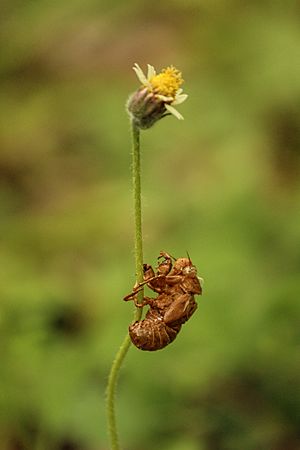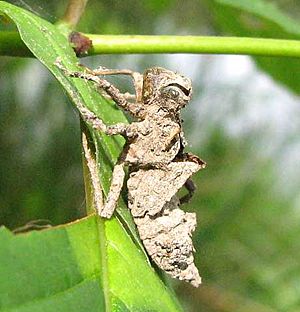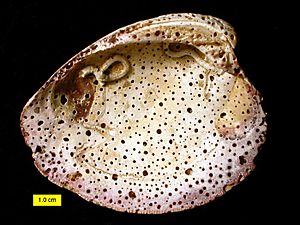Exoskeleton facts for kids
An exoskeleton is like a strong, hard shell on the outside of an animal's body. It supports and protects the animal, unlike our own bones, which are inside us. Many animals without backbones, like snails with their shells, have external hard parts. But when we talk about exoskeletons, we usually mean the ones found on arthropods. Arthropods include insects, spiders, centipedes and millipedes, and crabs and lobsters. These amazing outer coverings first appeared about 550 million years ago. They played a big part in the "Cambrian explosion," a time when many new animal types suddenly appeared on Earth.

Contents
What Exoskeletons Do
Exoskeletons have many important jobs. They protect the animal from danger, like predators or pests. They also help support the animal's body. For animals that live on land, exoskeletons act like a shield against drying out.
These outer shells also provide a strong framework for muscles to attach to. This allows the animal to move, jump, and do many other things. Many exoskeletons contain a tough material called chitin. Adding calcium carbonate makes them even harder and stronger.
Inside an arthropod's exoskeleton, there are special parts called apodemes. These are like internal anchors where muscles connect. Apodemes are made of chitin and are very strong. They can even stretch like a spring to store energy for jumping, especially in animals like locusts.
Different Kinds of Exoskeletons

Many different animals have exoskeletons, and they are made from various materials.
- Some fish, like Ostracoderms, and turtles use bone or cartilage.
- Chitin forms the exoskeleton in arthropods, including insects, arachnids (like spiders), and crustaceans (like crabs and lobsters). Some fungi and bacteria also have chitin.
- Calcium carbonate makes up the shells of snails, bivalves, and some worms.
- Silica is found in the tiny exoskeletons of diatoms and radiolaria.
- One type of snail, the scaly-foot gastropod, even uses iron to make its shell!
Some tiny creatures, like certain foraminifera, build their exoskeletons by gluing together sand grains or shell pieces. It's important to know that echinoderms (like starfish) do not have true exoskeletons. Their hard parts are actually inside their living tissue.
Exoskeletons have developed many times in different animal groups. Some mammals, like the armadillo and pangolin, have tough outer coverings that act like an exoskeleton. The armadillo's armor is made of bone, and the pangolin's is made of hair. Reptiles like turtles and Ankylosaurs have bony armor or scales.
How Exoskeletons Grow
Since exoskeletons are hard, they can't stretch as an animal grows. So, animals with true exoskeletons, like arthropods, have to shed their old shell. This process is called molting or ecdysis.
Here's how it works:
- A new, soft exoskeleton forms underneath the old one.
- The animal then sheds its old, rigid shell.
- The new shell is soft and flexible at first. The animal quickly takes in air or water to expand its body, making the new shell as big as possible.
- Once the new shell hardens, the animal can then fill the extra space by eating and growing.
If an animal can't shed its old exoskeleton, it can get stuck or even suffocate. This also stops young animals from growing up and reproducing. Some insect pesticides work by stopping insects from molting properly.
Exoskeletons and Fossils
Exoskeletons are very helpful for scientists who study fossils. Because they are hard, exoskeletons can last a long time after an animal dies. Soft body parts usually rot away before they can become fossils.
When an exoskeleton is preserved, it can tell us a lot about an ancient animal. For example, exoskeletons often have "muscle scars." These are marks where muscles were attached. By studying these marks, scientists can figure out how the animal moved or what its internal parts might have looked like.
Hard exoskeletons first appeared in the fossil record around 550 million years ago, just before the Cambrian period. Some scientists believe that the development of these hard outer shells helped drive the "Cambrian explosion." This was a time when many new types of animals appeared, leading to a race between predators developing new ways to attack and prey developing new ways to defend themselves.
See also
 In Spanish: Exoesqueleto para niños
In Spanish: Exoesqueleto para niños



